 |
 |
 |
| |
Identification of mutations predictive of a diminished response to darunavir/ritonavir (refined profile): analysis of data from treatment-experienced patients in POWER 1, 2, 3 and DUET-1 and DUET-2
|
| |
| |
Reported by Jules Levin
6th European HIV Drug Resistance Workshop, Budapest, Hungary, 26-28 March 2008
Sandra De Meyer,1 Inge Dierynck,1 Erkki Lathouwers,1 Ben Van Baelen,1 Tony Vangeneugden,1 Sabrina Spinosa-Guzman,1 Gaston Picchio,2 Marie-Pierre de Bˇthune1
1Tibotec BVBA, Mechelen, Belgium; 2Tibotec Inc., Yardley, PA, USA
Author Conclusions
This larger clinical dataset enabled new analyses to identify mutations associated with a diminished response to DRV.
These analyses not only assessed the influence of baseline mutations on virological response and susceptibility to DRV, but also the development of mutations in patients experiencing VF
- 10 out of the 11 DRV RAMs had been previously identified4
- T74P was the only newly identified mutation, resulting in the following 2007 DRV RAMs: V11I, V32I, L33F, I47V, I50V, I54L/M, T74P, L76V, I84V and L89V.
The presence of >/=3 2007 DRV RAMs was associated with a diminished virological response.
While the number of DRV RAMs of both the 2006 and 2007 lists were predictive of virological response, a slightly better prediction was observed with the 2007 DRV RAMs list.
Introduction
· The efficacy and tolerability of the protease inhibitor (PI) darunavir (DRV; TMC114) with low-dose ritonavir (DRV/r) has been demonstrated in clinical trials of treatmentexperienced, HIV-1-infected patients.1-3
· According to pooled resistance data from the Phase IIb randomised, controlled POWER 1 and 2 studies (TMC114-C213 and C202) and the open-label POWER 3 analysis (TMC114-C215 and C208), treatment-experienced patients who initiated treatment with DRV/r 600/100mg bid (n=458) had a diminished response to DRV/r when at least three of 11 specific protease mutations were present at baseline4
- the 11 protease mutations identified as DRV resistance-associated mutations (RAMs) in 2006 were V11I, V32I, L33F, I47V, I50V, I54L/M, G73S, L76V, I84V and L89V.
· The DUET-1 and DUET-2 trials (TMC125-C206 and C216) are two, randomised, placebo-controlled, double-blinded, Phase III trials investigating the efficacy and safety of the NNRTI etravirine (TMC125), as part of a regimen including DRV/r investigator-selected NRTIs and optional enfuvirtide (ENF) in highly treatment-experienced patients.5,6
· Given that the patient populations in the POWER and DUET trials were similar, the data were pooled to increase the strength of the present resistance analyses.
· This larger dataset was used to identify new mutations and update the current list of DRV RAMs (2006) to create the 2007 DRV RAMs list.
Results
Influence of type of protease mutations on DRV in-vitro susceptibility (criterion 1)
The effect of the presence or absence of protease mutations on DRV FC was tested using a univariate model. Based on this model, 26 mutations were estimated to lead to an increase in DRV FC of at least two-fold, all with a significance level of <0.05. A stepwise regression model conducted thereafter yielded 15 protease mutations associated with a >1.5-fold increase in DRV FC: L10F, V11I, V11L, V32I, L33F, I47V, I50V, I54L, I54M, G73C, T74P, L76V, V82I, I84V and L89V.
Influence of type of baseline protease mutations on virological response (criterion 2)
Baseline protease mutations associated with a diminished response at Week 24 as compared to the overall response were identified in DRV/r-treated patients who either did not use or who re-used ENF. The presence of the protease mutations V11I, G16A, K20V, V32I, E35N, I47V, I50V, I54L, I54M, I66V, T74P, L76V, I84V and L89V at baseline were associated with a diminished virological response at Week 24 (Figure 1).
Figure 1. Virological response (HIV-1 RNA <50 copies/mL, TLOVR non-VF censored) at Week 24 by presence of specific protease mutations at baseline in DRV/r patients who did not use or who re-used ENF.
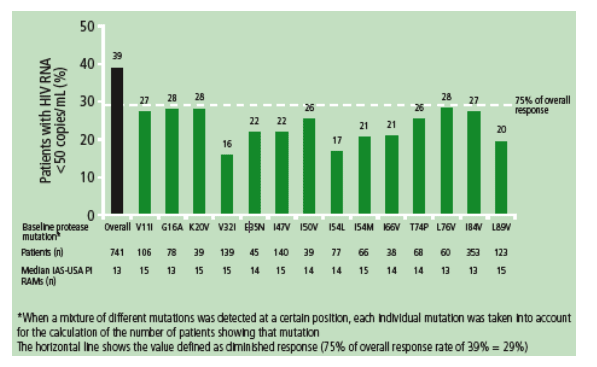
Development of protease mutations in VFs by rebound (criterion 3)
Of the 1,071 patients studied, 18% (n=188) met the rebounder definition. Baseline and endpoint genotypes were available for 185/188 rebounders.
Protease mutations that developed in >/=10% of the analysed rebounders are shown in Table 1.
Table 1. Protease mutations that developed at endpoint in >/=10% of rebounders.
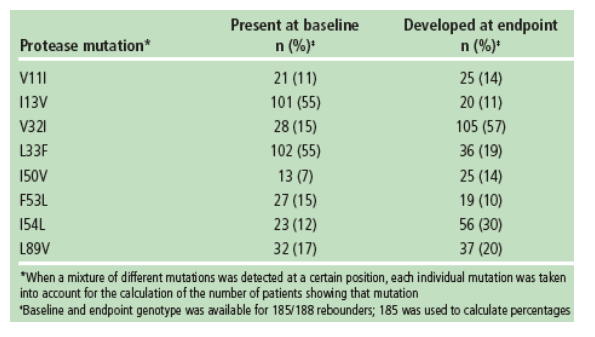
Compilation of the 2007 DRV RAMs list
Eleven protease mutations met at least two of the three predefined criteria and thus were included in the 2007 DRV RAMs list (Table 2). The only difference between the 2006 and 2007 DRV RAMs lists is the exclusion of the G73S and the addition of the T74P protease mutation.
Table 2. Compilation of the 2007 DRV RAMs list.
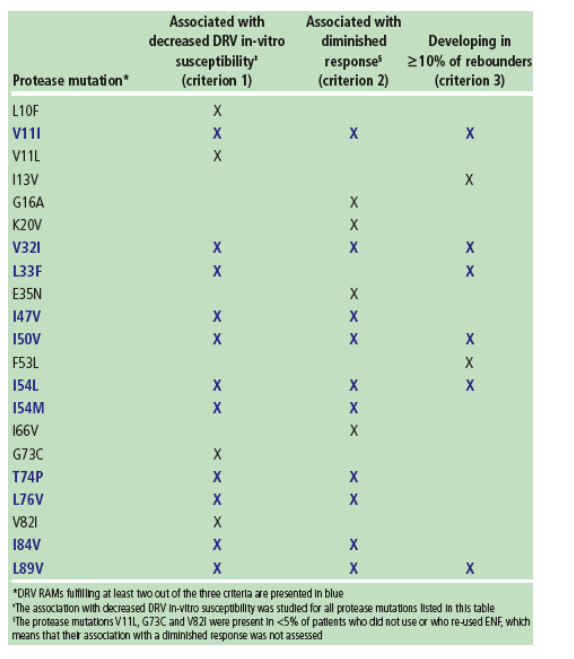
Each of the 11 DRV RAMs in the 2007 list was present with a median of
13-15 IAS-USA PI RAMs7 at baseline.
Influence of number of baseline 2007 DRV RAMs on DRV in-vitro susceptibility and on virological response
The median DRV FC increased with increasing numbers of 2007 DRV RAMs. In previous analyses, a lower and upper clinical cut-off (CCO) of 10 and 40 were determined.4 A median DRV FC >10 was found with >/=3 of the 2007 DRV RAMs (Figure 2).
Figure 2. DRV FC by number of baseline 2007 DRV RAMs.
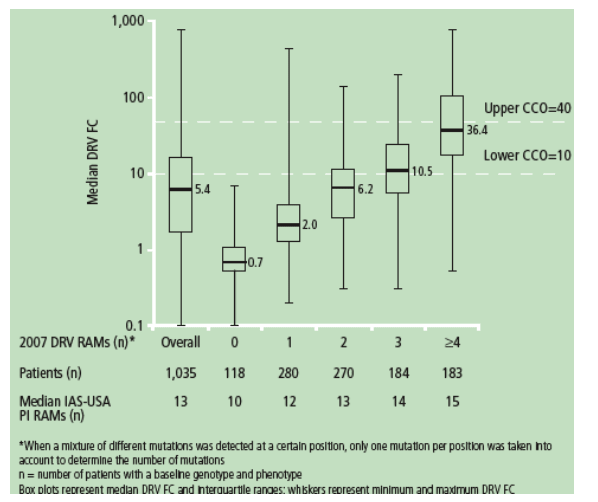
In patients who did not use or who re-used ENF, the virological response rate decreased with increasing numbers of baseline 2007 DRV RAMs. A diminished virological response at Week 24 was observed in this group for patients with >/=3 2007 DRV RAMs at baseline (Figure 3). This result is consistent with previous analyses.4
Figure 3. Virological response (HIV RNA <50 copies/mL, TLOVR non-VF censored) at Week 24 by number of 2007 DRV RAMs at baseline in DRV/r patients who did not use or who re-used ENF
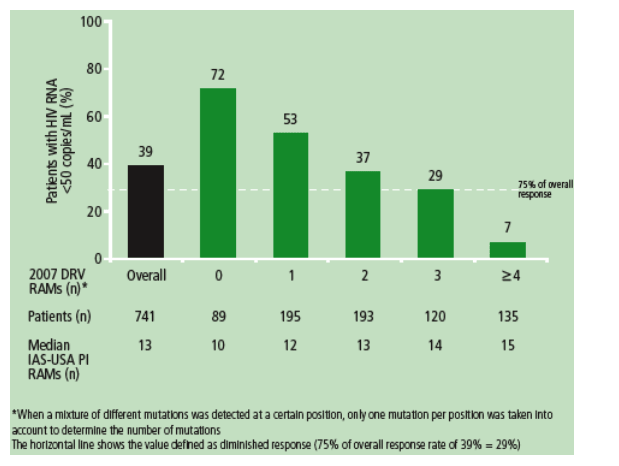
An ANOVA model showed that the number of DRV RAMs in both the 2006 and 2007 lists were significant predictors of response (change in viral load, NC=F non-VF censored; p<0.001), and that the number of DRV RAMs in the 2007 list were slightly more predictive of response.
References
1. Clotet B, et al. Lancet 2007;369:1169-78.
2. Molina JM, et al. J Acquir Immune Defic Syndr 2007;46:24-31.
3. Madruga JV, et al. Lancet 2007;370:49-58.
4. De Meyer S, et al. 15th International HIV Drug Resistance Workshop, Sitges, Spain, 13-17 June 2006. Abstract 73.
5. Madruga JV, et al. Lancet 2007;370:29-38.
6. Lazzarin A, et al. Lancet 2007;370:39-48.
7. Johnson VA, et al. Top HIV Med 2006;14:125-30.
|
| |
|
 |
 |
|
|